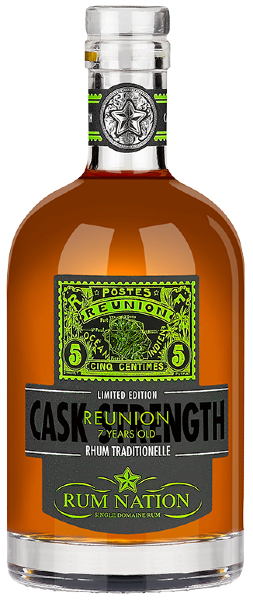This is not the first Rum from Rum Nation on these pages and not even the first Rhum from Ile de la Réunion. Earlier I reviewed a Rhum from Rivière du Mât and I thought that one was nothing short of amazing, even though it was a reduced to a measly 42% ABV. Rivière du Mât isn’t even the most popular distillery from the Island, that honorary mention goes to Savanna, and then especially to the Rhum Agricoles Savanna produces. Savanna distillery was founded in 1870 in Saint Paul on the north west corner of the island and supposedly made Rhums based on molasses only. Fast forward many years. Since 1964 the distillery runs a continuous still. In 1992 the distillery moved to Bois-Rouge on the north eastern corner of the island, by today’s standard, some 50 kilometres by car. Today the distillery makes Rhum Agricoles, for which it is now mostly known, as well as Rhum Traditionelle (molasses based), some of the Rhums are of the high ester kind.
The Cask Strength series is a somewhat recent addition to the Rum Nation portfolio. The first Rum released in this series is actually this 7yo rum from Réunion, probably distilled at Savanna, and matured in ex-Cognac casks. Savanna uses a lot of ex-Cognac casks, because may of the official releases have been matured in Cognac casks as well. After this, examples from Jamaica and Guyana were also released.
 Color: Orange Gold.
Color: Orange Gold.
Nose: Fruity and creamy. Fresh (air) with toffee and caramel. Slightly funky and somewhat sweet smelling. Lightly waxed. Sweet White Wine, mocha, licorice and leather. Some dust on rainwater. Definitely has some traits from Rhum Agricole. The nose reminds me of J.M Agricoles. More J.M than, lets say, Rivière du Mât (Rhum Traditionelle). Initially some sweet citrus bathroom cleaner, soft chlorine and ozone from a pool or jacuzzi. These aroma’s are short lived, and are gone soon, never to return again (unless you pour yourself another one). Black tea with lemon. Hints of cookie dough, moist brown sugar, wood and sweet mint candy. Malty and biscuity, and thus some very soft oak. A whiff of fresh air, yet also spicy, a mix of many dried kitchen spices, yet also some cinnamon and hints of toasted oak (soft). Some unripe banana and also the brown bits of a banana skin and some aroma’s of overripe, almost rotting yellow fruits. Don’t worry, the Rhum still smells quite nice and is nicely balanced as well. Rum Nation also bottles quite a lot of Cask Strength Savanna’s, and I have one here to compare it with. Based on the smell of both, it is safe to assume this 7yo is a Savanna as well, nevertheless, one can be never entirely sure (please read on). By the way, the day after, the empty glass smells just wonderful. Very fruity and with hints of the fireplace at Christmas, or a nice bonfire. Love it!
Taste: Big and still sweet, although the back label mentions this is “for connoisseurs that don’t like excessive sweetness“, it is sweet but not excessively so. This sweetness is balanced out with quite some spicy wood, and toasted wood as well. Distant pine anyone? Quite hot going down. Brown sugar and candied cinnamon mixed with cola notes for freshness or zest. Very tasty. Well balanced stuff of high quality. Now for an interesting remark. Where the smell is all Savanna, there are some notes in the taste that do remind me a bit of Rivière du Mât (also from the Island of Réunion). An industrial, fatty, motor oil aroma. Crushed almonds with some woody bitterness mixed with brown sugar. I’m still convinced this is a Savanna, the smell is there and since Rum Nation has many other Savanna’s in their portfolio it is simply highly likely, but as said above, one can never be sure. Even though this is bottled @ 60.5% ABV, it isn’t hot all the time, like many other high strength R(h)ums. Licorice and Cognac, (really?), in the finish, as well as some wood. The aftertaste shows even some more wood accompanied by its bitterness. The Casks used must have been quite active or caught a lot of sunshine.
I say, high quality, big and very tasty. Lance mentions in his review: “It’s very much like the new wave of Jamaican rums now making such big waves – Hampden and Worthy Park in particular, because this presses many of the same buttons“. This is my sentiment exactly. It presses the same buttons without even being really close to those in smell nor taste. Its big and estery and bottling this @ 60.5% ABV helps the Rhum come across big time. Since this has been bottled in Rum Nation’s Cask Strength series, only mentioning it is a 7yo hailing from Réunion, thus calling it an entry level Rhum, (yeah right), this therefore also damn affordable. Heartily recommended and definitely not for novices to R(h)um. If you are just that, you should by it all the same, but do not open it just yet.
Points: 87
 Color: Gold.
Color: Gold. Color: Orange Gold.
Color: Orange Gold. Color: Bright orange gold. Radiant with a pink hue.
Color: Bright orange gold. Radiant with a pink hue. Color: Copper gold. No pink or red hue.
Color: Copper gold. No pink or red hue. Color: Copper gold.
Color: Copper gold. Color: Pale straw. Very light.
Color: Pale straw. Very light. Color: Dark gold copper, marginally darker than the 50% ABV expression.
Color: Dark gold copper, marginally darker than the 50% ABV expression. Color: Slightly copper gold.
Color: Slightly copper gold.